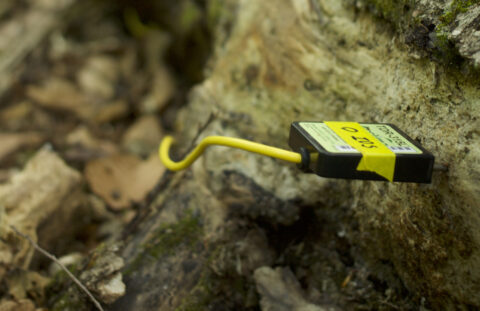Hello again from the Forest Observation Sensing Transformative Experience in Research (FOS-TER) team at Plymouth State University!
We have had a packed week constructing a micrometeorological station in the Watershed Sensing (WATSEN lab) and hearing research findings at the annual Hubbard Brook Cooperators’ Meeting. From greater findings about nitrate and the impact of calcium silicate on the Watersheds 1 and 6, to understanding the activity of moose and deer around the forest, we learned a great deal about the work going on at the Hubbard Brook Experimental Forest.
Elizabeth Jurkowski presented our project, “Dead Wood Moisture Variability in a Sugar Maple Log” (lovingly called “Frankenlog” in our lab here). We received some excellent questions concerning the validity of the data we’ve been collecting. This question has been a key component of the summer research that Rachel Allen and Elizabeth are focusing on.

The furthest time domain reflectometry sensor on the log in Watershed 3.
Part of the exciting nature of the log research has been the novelty of many of our methods. However, with novelty comes the need for quality assurance and control. Since these sensors have never been used to test the moisture content in logs, we have to make sure that they are collecting accurate data by dissecting the sugar maple log (poor Frankenlog!) and testing the moisture content using drying techniques. There has been pretty lively discussion around the parameters and logistics behind a benchtop experiment to test the quality of the TDR (time domain reflectometry) sensors’ data. Fun fact, you can actually dry a log reasonably well with a toaster oven or microwave, but we have decided to move forward with a convection oven once we have a sufficient amount of field data.
This coming week has our team focused on planning out that benchtop experiment in the WATSEN lab at Plymouth State. We will also be tromping around at Hubbard Brook installing a micrometeorological station and approximately 60 more sensors in the sugar maple log in Watershed 3. If you happen to be around PSU’s Boyd Hall or up at the HBEF and see four women carrying quite a bit of steel piping and meteorological sensors, come say hi! We’d love to share more about our project and discuss our takeaways from the annual meeting.
